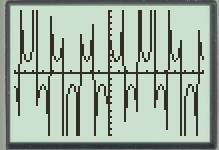
Concept explainers
To verify: The given
Explanation of Solution
Given information:
The trigonometric identity
Formula used:
The Pythagorean identity
Calculation:
Consider the function,
The left hand side of equation is,
Recall Pythagorean identity
Apply it in the left hand side of the equation.
Since, left hand side and right hand side is equal, therefore, the trigonometric identity
To verify the result graphically, construct the graphs of the equations
Step 1. Press
Step 2. Enter the function
Step 3. Enter the function
Step 4: Press the
The result obtained is provided below,

Observe that graph of
Therefore, the identity holds true.
Hence, the trigonometric identity
Chapter 5 Solutions
EBK PRECALCULUS W/LIMITS
- For number 9 The answer is A Could you show me howarrow_forwardThe answer is B, Could you please show the steps to obtain the answerarrow_forward2. Suppose that U(x, y, z) = x² + y²+ z² represents the temperature of a 3-dimensional solid object at any point (x, y, z). Then F(x, y, z) = -KVU (x, y, z) represents the heat flow at (x, y, z) where K > 0 is called the conductivity constant and the negative sign indicates that the heat moves from higher temperature region into lower temperature region. Answer the following questions. (A) [90%] Compute the inward heat flux (i.e., the inward flux of F) across the surface z = 1 - x² - y². (B) [10%] Use the differential operator(s) to determine if the heat flow is rotational or irrotational.arrow_forward
- Could you show why the answer is B Using polar coordinates and the area formulaarrow_forward1. The parametric equations x = u, y = u cos v, z = usin v, with Ou≤ 2, 0 ≤ v ≤ 2π represent the cone that is obtained by revolving (about x-axis) the line y = x (for 0 ≤ x ≤2) in the xy-plane. Answer the following questions. (A) [50%] Sketch the cone and compute its surface area, which is given by dS = [ | Ər Or ди მა × du dv with S being the cone surface and D being the projection of S on the uv-plane. (B) [50%] Suppose that the density of the thin cone is σ(x, y, z) = 0.25x gr/cm². Compute the total mass of the cone.arrow_forwardThe value of sin (2V · F) at x = 3, y = 3, z = −4, where F -0.592 -0.724 0.661 -0.113 -0.822 -0.313 0.171 0.427 = (-2x² + -4,2yz − x − 3, −5xz - 2yz), isarrow_forward
- The correct answer is C Could you show me whyarrow_forwardThe graph of f(x) is given below. Select each true statement about the continuity of f(x) at x = -4. Select all that apply: ☐ f(x) is not continuous at x = -4 because it is not defined at x = −4. ☐ f(x) is not continuous at x = -4 because lim f(x) does not exist. x-4 f(x) is not continuous at x = -4 because lim f(x) = f(−4). ☐ f(x) is continuous at x = -4. x-4 ين من طلب نہ 1 2 3 4 5 6 7arrow_forwardThe graph of f(x) is given below. Select each true statement about the continuity of f(x) at x = -1. -7-6-5 N HT Select all that apply: ☐ f(x) is not continuous at x = -1 because it is not defined at x = -1. ☐ f(x) is not continuous at -1 because lim f(x) does not exist. x-1 ☐ f(x) is not continuous at x = -1 because lim f(x) = f(−1). ☐ f(x) is continuous at x = -1. x-1 5 6 7arrow_forward
- Use the shell method to find the volume of the solid generated by revolving the region bounded by the curves and lines about the y-axis. y=x², y=7-6x, x = 0, for x≥0arrow_forwardThe graph of f(x) is given below. Select all of the true statements about the continuity of f(x) at x = −3. -7-6- -5- +1 23456 1 2 3 4 5 67 Select the correct answer below: ○ f(x) is not continuous at x = f(x) is not continuous at x = f(x) is not continuous at x = f(x) is continuous at x = -3 -3 because f(-3) is not defined. -3 because lim f(x) does not exist. 2-3 -3 because lim f(x) = f(−3). 2-3arrow_forwardCould you explain how this was solved, I don’t understand the explanation before the use of the shift property As well as the simplification afterwardsarrow_forward
 Calculus: Early TranscendentalsCalculusISBN:9781285741550Author:James StewartPublisher:Cengage Learning
Calculus: Early TranscendentalsCalculusISBN:9781285741550Author:James StewartPublisher:Cengage Learning Thomas' Calculus (14th Edition)CalculusISBN:9780134438986Author:Joel R. Hass, Christopher E. Heil, Maurice D. WeirPublisher:PEARSON
Thomas' Calculus (14th Edition)CalculusISBN:9780134438986Author:Joel R. Hass, Christopher E. Heil, Maurice D. WeirPublisher:PEARSON Calculus: Early Transcendentals (3rd Edition)CalculusISBN:9780134763644Author:William L. Briggs, Lyle Cochran, Bernard Gillett, Eric SchulzPublisher:PEARSON
Calculus: Early Transcendentals (3rd Edition)CalculusISBN:9780134763644Author:William L. Briggs, Lyle Cochran, Bernard Gillett, Eric SchulzPublisher:PEARSON Calculus: Early TranscendentalsCalculusISBN:9781319050740Author:Jon Rogawski, Colin Adams, Robert FranzosaPublisher:W. H. Freeman
Calculus: Early TranscendentalsCalculusISBN:9781319050740Author:Jon Rogawski, Colin Adams, Robert FranzosaPublisher:W. H. Freeman
 Calculus: Early Transcendental FunctionsCalculusISBN:9781337552516Author:Ron Larson, Bruce H. EdwardsPublisher:Cengage Learning
Calculus: Early Transcendental FunctionsCalculusISBN:9781337552516Author:Ron Larson, Bruce H. EdwardsPublisher:Cengage Learning





